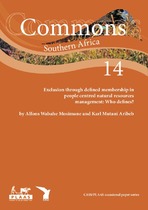| dc.contributor.author | Mosimane, Alfons Wabahe | |
| dc.contributor.author | Aribeb, Karl Mutani | |
| dc.date.accessioned | 2019-03-07T12:14:55Z | |
| dc.date.available | 2019-03-07T12:14:55Z | |
| dc.date.issued | 2005 | |
| dc.identifier.citation | Mosimane, A. W. & Aribeb, K. M., 2005. Exclusion through defined membership in people-centered natural resources management: Who defines?. Cape Town: Institute for Poverty Land and Agrarian Studies (PLAAS). | en_US |
| dc.identifier.uri | http://hdl.handle.net/10566/4427 | |
| dc.description.abstract | This paper investigates how community-based natural resource management (CBNRM) has determined membership to rights over forestry and wildlife resources in Botswana, Namibia and Zimbabwe. The legal frameworks in these countries emphasise geographic location, which can be referred to as a ‘community of place’, with the residents determining membership. While recognising the limitations highlighted by CBNRM critics, it must be acknowledged that authority and boundary (‘area of jurisdiction’) are equally important. Any poorly defined link between authority and boundary would invite criticism, and would be seen as an essential flaw in any common property regime. Membership of wildlife and forest management regimes in Botswana, Namibia and Zimbabwe is based on geographic location and residence, the latter being based on social elements such as kinship and marriage, cultural affiliation and social networks. | en_US |
| dc.language.iso | en | en_US |
| dc.publisher | Institute for Poverty Land and Agrarian Studies (PLAAS) | en_US |
| dc.relation.ispartofseries | Commons South Africa;14 | |
| dc.subject | Natural resources management | en_US |
| dc.subject | People-centered | en_US |
| dc.subject | Botswana | en_US |
| dc.subject | Zimbabwe | en_US |
| dc.subject | Namibia | en_US |
| dc.title | Exclusion through defined membership in people-centered natural resources management: Who defines? | en_US |
| dc.type | Book | en_US |

